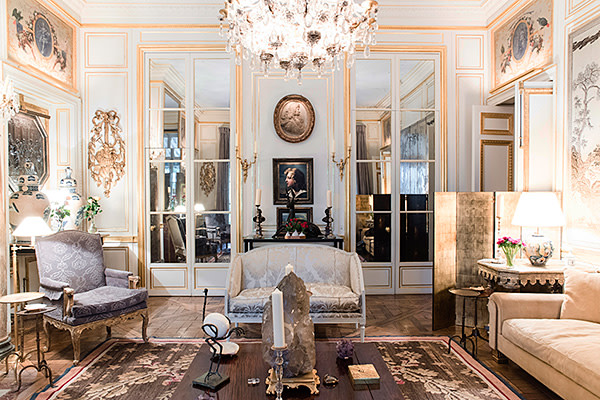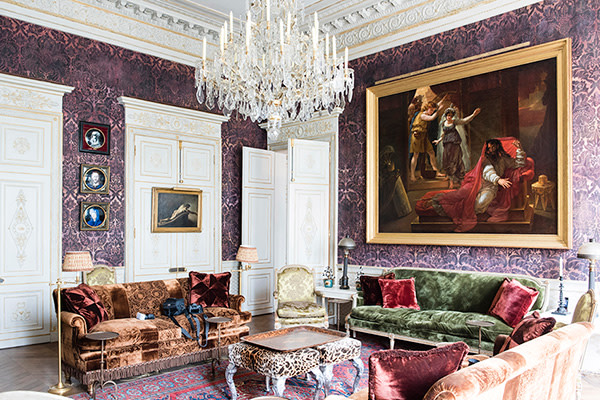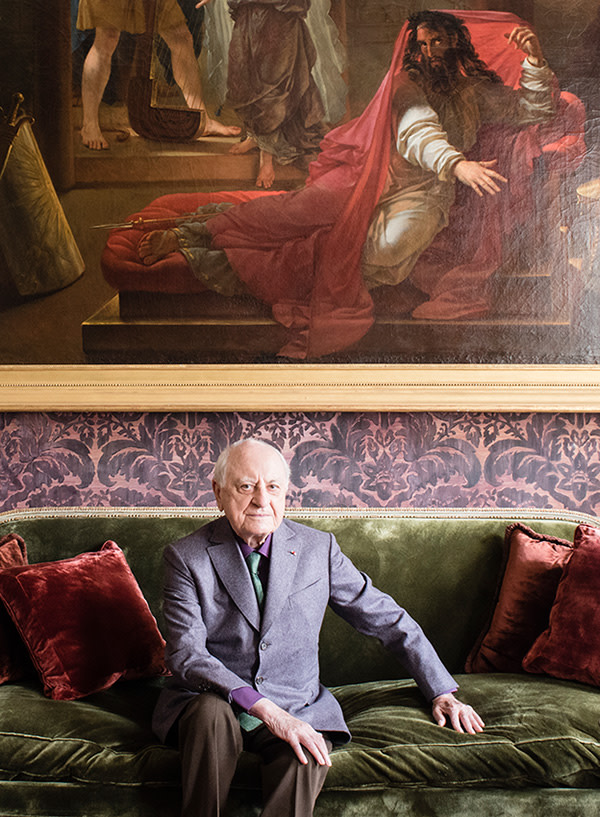Pierre Bergé, partner of the late Yves Saint Laurent
Simply sign up to the Life & Arts myFT Digest -- delivered directly to your inbox.
Walk into Pierre Bergé’s Paris maisonette, an Aladdin’s cave of exquisitely arranged paintings, antiques and curios, and it is easy to forget that the business partner and long-time lover of Yves Saint Laurent has sold almost everything he has ever owned.
Every wall, surface and corner is choreographed in an eclectic mix of styles — Japanese, north African, different European centuries — brought together with such harmony and beauty that it makes you wonder whether you have spent your entire life floating in a sensory deprivation tank.

One minute, we are in an elegant corridor with chandeliers and a black and white marble floor flanked by mirrors. The next, a small, dark sitting room with a high-backed leopard-print sofa looking up at frowning African masks and tortured paintings by Bernard Buffet. Yet all of this is the dregs. In 2009, Bergé sold hundreds of bronzes, antiques, sculpture and paintings — Picasso, Matisse and Mondrian, to name a few — that he had collected over decades with Saint Laurent. Dubbed the sale of the century, the collection fetched close to €374m.
Yet Bergé wasn’t finished. In 2015, he sold part of his rare-books collection for €11.7m. His volume of poet Louise Labé’s Œuvres from 1555 fetched €525,000. Among the few items that Bergé kept was a volume of Requiem by Jean Cocteau; it contained a dedication to him from the author.
This month, he sold the contents of his wine cellar. The collection included a Château Lafite Rothschild from 1895. Another bottle, a 1907 Heidsieck Monopole, salvaged from the wreckage of the Jönköping, a Swedish schooner sunk by a German submarine in 1916, sold for €6,010.

Sitting in his sumptuous ground-floor drawing room overlooking a small but breathtaking garden designed by Pascal Cribier and Louis Benech, the 85-year-old Bergé has a simple explanation: “I’m like a cat. I like to clean up after myself.”
Yet it goes deeper than that. The French industrialist, a compact and formal figure who speaks in measured tones, is busy raising funds to establish two museums, in Paris and Marrakesh. When completed, they will display the 5,000 haute couture garments and 15,000 accessories as well as thousands of sketches and drawings he has by Saint Laurent that span the designer’s four decades of work from 1962 until his retirement in 2002.

The location of the Paris museum, at 5 Avenue Marceau, is where Saint Laurent put his creations together. In Marrakesh, Bergé is constructing a museum next to the Majorelle Garden, close to the private villa where Saint Laurent worked on his new collections. The couple bought the 12-acre botanical gardens in 1980 to save them from development. The idea, he says, is to have a permanent display of Saint Laurent’s work in a place that became an integral part of their lives after they first bought property there in 1966. “It was love at first sight,” he says of Marrakesh. “And it changed our lives completely. Yves always said Marrakesh taught him about colour.”
The second reason for the sale is that Saint Laurent’s death from brain cancer in 2008 meant the end of their art-collecting partnership. Much of the collection’s raison d’être, after all, was their shared passion in the choice of works as well as their subsequent appreciation. “I sold absolutely all the artworks because Yves was dead,” he says.
Bergé fell in love with the designer at their first meeting in 1958, but in later years he wrestled with Saint Laurent’s drug and alcohol abuse. The couple separated in 1976, with Saint Laurent moving to another Paris residence nearby. But the two remained close until the end, and signed a civil union pact shortly before the designer’s death.

“I think about him very, very often,” he says of Saint Laurent. “You miss people when you cannot share something with them, when you cannot tell him to see a particular painting or to read a particular book.”
Bergé helped to build the Yves Saint Laurent couture house, using his business acumen — he is part owner of Le Monde newspaper, has a restaurant and a caviar farm, and is president of his foundation.

Yet he argues that haute couture in today’s world is “meaningless”. “It used to be a dialogue between an haute couturier and rich women, who led a certain lifestyle that has completely disappeared,” he says. “Today, the dialogue is between a fashion designer and the street.” He is not nostalgic, though. “I hate nostalgia,” he says. “I like modern life because everything is easier. Science has made formidable discoveries and there is a change of mores, an access to liberty in every domain.”
Bergé moved to his current residence on the Left Bank’s Rue Bonaparte 24 years ago. It is an 18th-century house where Edouard Manet was born in 1832. In the drawing room, a monochrome Japanese screen depicting deer in a landscape of gnarled trees and cherry blossom decorates one wall. On another, there is a small portrait by Théodore Géricault, the French Romantic master.
Favourite thingBergé resists the idea of having to choose a favourite object, insisting he cannot pick one item over another. He even references Jean Cocteau’s response when he was asked to name the one thing he would take from his house if it were on fire: “I would take the fire.”
Eventually, he settles on a still life of a flower in a vase by Bernard Buffet, the French painter and Bergé’s one-time lover before he met Yves Saint Laurent. “I’m choosing this one because the others are too big to take down,” he says. On the back, in Buffet’s jagged handwriting, is a message dated August 1955: “To Pierre Bergé.”
Next door is his favourite room, the small sitting room with the Buffets and African masks. The decor is like the rest of the ground floor — dense and eclectic yet perfectly coherent. Bergé commissioned Roberto Peregalli and Laura Sartori Rimini, the Milanese designers, to refurbish the upper floor. The effect is startling: lighter and more open than downstairs, the proportions and symmetry of the rooms feel French with a dash of 19th-century St Petersburg.
All of it, including the petit salon, with its vaulted ceiling painted with a golden lattice trompe d’oeil, is pitch-perfect. The star, though, is Bergé’s library, a modestly sized room with neat gilt-trimmed shelves and 19th-century lamps set on a central reading table. It holds all that remains of Bergé’s book collection and yet there is row upon row of volumes that I have never seen before and will probably never see again.
First editions abound, from Charles Dickens and Samuel Johnson to Oscar Wilde and Virginia Woolf. “F” takes me to Flaubert. Bergé has tomes I and II of an 1870 edition of the French writer’s Sentimental Education, several 1863 editions of Salammbô and four editions of Madame Bovary from 1856. He reaches for a red leather-bound volume of The Temptation of Saint Anthony. This 1874 first edition is in mint condition — enough to make it very special. “Open it,” Bergé says. Inside, there is a handwritten message from the author to Victor Hugo. “You have to understand the most important thing about a book is the text,” he says, pointing out that he owns a Kindle. “But that is a bit better than a paperback.” Over the next two years, however, Bergé plans to sell even these books.

There is third reason for selling all his art, furniture, objets d’art, books and wine — one that speaks to Bergé’s intellectual approach to his collecting: he sees it as a project — and projects have to have an end if they are to be successful.
The “project” part explains why he and Saint Laurent rejected plenty of artwork over the years on the grounds that it would not fit with the rest. “It was a collection,” he says. “You have to remember that.” For his library, Bergé also refused admission to many authors, including Albert Camus, whom he once described as “a philosopher for schoolteachers”.

We return to the small sitting room on the ground floor. Do the sales spell the end of his collecting days? “When you buy an object, it is just an object,” Bergé says. “When you buy a second, it is a pair. A third? It is the beginning of a collection.”
As he finishes the sentence, he looks at a side table next to the sofa. It has some small antique skulls carved from bone and other materials. There are about three dozen of them already, but Bergé admits the collection is growing.
Adam Thomson is the FT’s Paris correspondent
Photographs: Pierre Faure
Comments